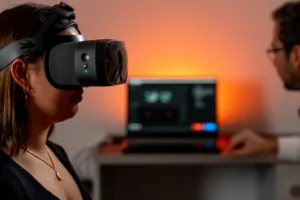Varjo, a developer of professional-grade VR/XR hardware and software, announced its partnership with machineMD, a Swiss medical device company, for the development of Neos, an innovative diagnostic device being developed for the early diagnosis of brain disorders. Neos will be integrated with the Varjo Aero headset and enable a complete, standardized, and instrument-based neuro-ophthalmologic examination using its built-in and industry-leading VR-based eye tracking solution.
“As a neuro-ophthalmologist, I use the eye as a window to the brain,” said Prof. Mathias Abegg, Medical Director of machineMD and Neuro-Ophthalmologist. “The Varjo Aero provides me with the most powerful and precise view through this window.”
Today, neuro-ophthalmic examinations are mostly performed manually and physicians need years of specialist training. Examinations are time-consuming and results are largely qualitative. Altogether, this leads to frequent incorrect or late diagnoses, and there is great untapped potential for new medical devices to better support healthcare professionals.
machineMD was founded to bring the diagnostic quality of highly trained specialists to a wide range of doctors and healthcare workers. The results are quantitative, objective, and reproducible and can be sent to clinics and specialists via telemedicine, enabling remote diagnosis and reducing examination time from 45 to 10 minutes. This brings the advantage that all patients are examined to the same standard, improving practice efficiency.
The Varjo Aero marks the first time that the medical community is leveraging a VR headset to measure eye tests to aid the diagnosis of brain disorders. The key component behind Neos is Varjo’s integrated eye tracking technology that is optimized to track and study eye movements in human-eye resolution. Varjo’s proprietary eye tracking technology is video-based, leveraging two built-in, high-speed cameras and infrared illumination to capture images of a user’s eyes at 200 hertz while measuring information such as pupil position, pupil dilation, interpupillary distance (IPD), focus or fixations, eye-motion patterns and more. Varjo’s eye tracking solution is industry-leading due to its unique use of infrared illumination patterns, allowing for more precise and consistent results even with the use of eyeglasses.
“VR-based eye tracking in combination with ophthalmology and neuroscience is opening up important new avenues for researchers and the larger medical community,” said Seppo Aaltonen, Chief Commercial Officer of Varjo. “A rare window into the brain is possible with the Varjo Aero headset and we are proud to partner with machineMD to make this technology a reality.”
Development of Neos is advancing rapidly with ongoing research studies at The University Hospital of Bern and several other clinics. machineMD recently raised over EUR 3m seed funding and is on track to launch Neos by the end of 2023.

